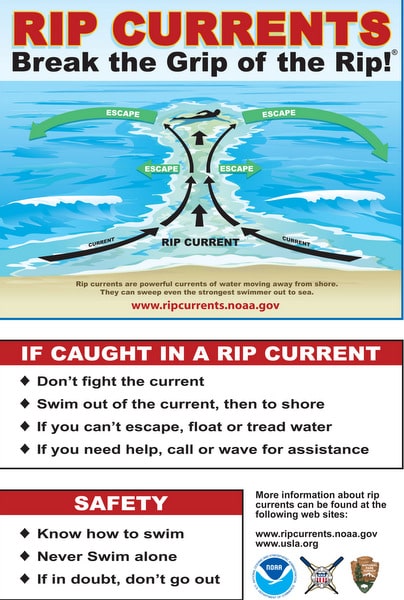Riptides or rip currents are one of the major dangers on Koh Chang. They occur in the the rainy season off all the beaches, but do also crop up during the drier months, usually after periods of high winds.
How are Rip Currents Formed?
Rip currents are formed when waves break near the shoreline, piling up water between the breaking waves and the beach. One of the ways that this water returns to sea is to form a rip current, a narrow jet of water moving swiftly away from shore, roughly perpendicular to the shoreline itself.
Typically, rip currents extend from near the shoreline, through the surf zone and past the line of breaking waves, with the definition of the surf zone as the area between the high tide level on the beach to the seaward side of the breaking waves.
Speed and Physical Signs of Rip Currents
With an average width of 3 to 6 metres, they slow down as they move offshore and beyond the breaking waves, but sometimes they can extend for hundreds of metres after the surf zone. Rip current speeds can be so slow that they are relatively innocuous, but, under certain wave, tide and beach conditions, their speeds can rise dramatically, exceeding 10kmph and far faster.
Signs that a rip current is present are very subtle, but look for a channel of churning, choppy water, an area having a notable difference in water colour, maybe a line of foam, seaweed, or debris moving steadily seaward or a break in the incoming wave pattern.
Effects of Rip Currents on You
Rip currents do not pull you under the water, but carry you away from the shore. When you first feel the rip, you tend to panic and the natural instinct is to fight it, by swimming against the current.
You get nowhere and are meanwhile dragged further and further out to sea, where exhausted and scared, you then find yourself unable to get back to the beach.
What to do in Rip Currents
- When you feel the rip taking you, remain calm/do not panic, so conserving energy
- Do not fight the current
- Think of it like being on a treadmill that you cannot stop, so your best way of escape is to step off to the side
- Stepping off the side of the treadmill means swim across the current in a direction following the shoreline
- When out of the current, swim/angle away from the current back towards towards shore
- If you cannot escape to the side, stay calm and try to float or tread water. The rip current strength eventually subsides offshore, (see above). When it does, start swimming towards shore
- If tired and exhausted, try to draw attention to yourself by facing the shore, waving your arms and making noise
- If you see someone in trouble, alert other people on the beach, try and shout instructions as above but remember many have drowned while trying to help others

Warning and Rescue System on Koh Chang
Koh Chang does use a red flag system on the beaches and lifeguards are sometimes present, but the best advice is to not stray beyond easy standing depth when the sea looks even a bit rough, especially in the rainy season.
Koh Chang Rescue, a volunteer service of locals, which has jet skis, speedboats and contact with the coastguard, do respond to emergencies. Numbers listed include 088 525 1100, 1669/1155 (Tourist Police).
All information courtesy of N.O.A.A, www.ripcurrents.noaa.gov.
Return to Koh Chang FAQs and Essential Information



